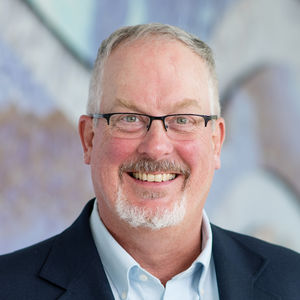
Edward “Ted” Hinchcliffe, PhD
Edward H. “Ted” Hinchcliffe is a Professor of Cell Biology at the Hormel Institute. Dr. Hinchcliffe received his B.A. in chemistry from the University of Dayton, and his Ph.D. from the University of Minnesota in the lab of Richard Linck, where he worked on tektins and tektin-associated proteins. During that time, he was a student in both the Physiology and Analytical Quantitative Light Microscopy (AQLM) courses at the Marine Biological Laboratory in Woods Hole, Massachusetts.
Dr. Hinchcliffe was an NIH NRSA post-doctoral trainee and American Cancer Society Senior research fellow in the laboratory of Greenfield “Kip” Sluder at the Worcester Foundation and University of Massachusetts Medical School, in Worcester, Massachusetts. There, he studied centrosome duplication and cell cycle regulation.
In 2001, he joined the biology department at the University of Notre Dame as an Assistant Professor, where he received a Research Scholar Award from the American Cancer Society. In 2008, Dr. Hinchcliffe joined the University of Minnesota’s The Hormel Institute as an Associate Professor.
In 2016, he became Professor of Cell Biology, Head of the TCBG Research Group, and Assistant Director of the Institute. In 2018, Prof. Hinchcliffe was named the I.J. Holton Endowed Professor of Cellular Dynamics. From 2002-2010, Dr. Hinchcliffe was an Instructor in the AQLM course at the MBL in Woods Hole, Massachusetts, where he taught digital image processing and live-cell imaging.
Education
- Post-doctoral research: Cell Biology, Worcester Foundation for Biomedical Research and Dept. of Cell Biology, University of Massachusetts Medical School, Worcester, Massachusetts
- PhD: Cell and Developmental Biology, University of Minnesota School of Medicine, Minneapolis, Minnesota
- BA: Chemistry, University of Dayton, Dayton, Ohio
Personal interests and hobbies
An amateur photographer, adventuresome cook, and avid cross country skier, Ted is also an ex-rugby player who follows the international game whenever and wherever he can find it.
Professional Memberships
- American Society for Cell Biology
Selected Awards
- 2018: I.J. Holton Endowed Professorship, Hormel Institute, University of Minnesota
- 2015: Faculty Mentor, American Society for Cell Biology, Minorities Affairs Committee, Faculty, Research and Education Development (FRED) Program, Houston, Texas
- 2010: Invited Editor, Seminars in Cell and Developmental Biology, “Molecular Motors in Mitosis”
- 2003-07: American Cancer Society, Research Scholar Award
- 2002-10: Course Faculty, Marine Biological Laboratory, Woods Hole, Massachusetts
- 2000-01: American Cancer Society (Massachusetts Division), Senior Postdoctoral Fellowship
- 1997-00: National Institutes of Health, T32 NRSA Post-Doctoral Trainee
- 1995: Student, Analytical and Quantitative Light Microscopy Course, MBL, Woods Hole, Massachusetts
- 1992: Student, Physiology Course, Marine Biological Laboratory (MBL), Woods Hole, Massachusetts
Research Interests
- Mechanisms coordinating centrosome reproduction with cell cycle progression
- The role played by aneuploidy in generating tumor cells
- Mitotic spindle assembly, and the regulation of chromosome segregation
- Post-translational modification of histone proteins at pericentromeric heterochromatin
- The role of bioactive sphingolipids in cell signaling and membrane architecture
- Light microscopycations
- Day, C.A., J.E. Hornick, A. Langfald, C.C. Mader, and E.H. Hinchcliffe (2018). Microsurgery and microinjection techniques in mitosis research. Methods in Cell Biology Vol 145 (In press).
- Mishra S.K., Y-G. Gao, Y. Deng, C.E. Chalfant, E.H. Hinchcliffe*, and R.E. Brown* (2017). CPTP: A sphingolipid transfer protein that regulates autophagy and inflammasome activation. Autophagy DOI: 10.1080/15548627.2017.1393129 *Corresponding authors.
- Hinchcliffe, E.H.*, C.A. Day, K. Karanjeet, S. Fadness, A. Langfald, K.T. Vaughan, and Z. Dong* (2016). “Chromosome missegregation during anaphase triggers p53 cell cycle arrest through histone H3.3 Ser31 phosphorylation”. Nature Cell Biology 18:668-675. *Corresponding authors.
- Simanshu, D.K., R. Kamlekar, D. Wijesinghe, X. Zou, X. Zhai, S. Mishra, J. Molotkovsky, L. Malina,
E.H. Hinchcliffe*, C. Chalfant*, R. Brown*, and D. Patel* (2013). “Nonvesicular trafficking by a ceremide-1-phosphate transfer protein regulates eicosanoids”. Nature 500:463-467. *Corresponding authors. - Shaw SL, and E.H. Hinchcliffe (2013). “65,000 shades of grey: use of digital image files in light microscopy”. Methods in Cell Biology 114:317-36.
- Hornick, J.E., C.C. Mader, E.K. Tribble, C.C. Bagne, K.T. Vaughan, S.L. Shaw, and E.H. Hinchcliffe (2011). “Amphiastral mitotic spindle assembly in vertebrate cells lacking centrosomes”. Current Biology 21:598-605.
- Collins, E.S., J.E. Hornick, T.M. Durcan, N.S. Collins, W. Archer, K.B. Karanjeet, K.T. Vaughan, and E.H. Hinchcliffe (2010). “Centrosome biogenesis continues in the absence of microtubules during prolonged S-phase arrest”. Journal of Cellular Physiology 225:454-465 (with cover photo).
- Durcan, T., E. Halpin, T. Rao, N. Collins, E. Tribble, J. Hornick, and E.H. Hinchcliffe (2008). “Tektin 2 is required for central spindle microtubule organization and the completion of cytokinesis”. Journal of Cell Biology 181:595-603 (with cover photo).
- Hornick, J., J. Bader, K. Trimble, E. Tribble, J. S. Breunig, E. Halpin, K. Vaughan, and E.H. Hinchcliffe. (2008). “Live-cell analysis of mitotic spindle formation in taxol-treated cells”. Cell Motility and Cytoskeleton 65:1-19 (with cover photo).
- Cardullo, R.A., and E.H. Hinchcliffe (2007). “Digital manipulation of brightfield and fluorescence images: Noise reduction, contrast enhancement, and feature extraction”. Methods in Cell Biology 81: 318-340.
- C.C. Mader, E.H. Hinchcliffe, and Y.L. Wang, (2007). “Probing cell shape regulation with patterned substratum: requirement of myosin II-mediated contractility”. Soft Matter 3:357-363.
- Durcan, T., E. S. Halpin, L. Casaletti, K. Vaughan, M. Pierson, S.L. Woods, and E.H. Hinchcliffe. (2007) “Centrosome duplication proceeds during mimosine-induced G1 cell cycle arrest”. J. Cellular Physiology 215:182-191 (with cover photo).
- Hinchcliffe, E.H. (2003). “Cell cycle: seeking permission from the mother centriole”. Current Biology 13:646-648.
- Hinchcliffe, E.H., F.J. Miller, M. Cham, A. Khodjakov, and G. Sluder. (2001) “Requirement of a centrosomal activity for cell cycle progression through G1 into S phase”. Science 291: 1547-1550.
- Hinchcliffe, E.H., C. Li, E.A. Thompson, J.L. Maller, and G. Sluder (1999). “Requirement of Cdk2 – cyclin E activity for repeated centrosome reproduction in Xenopus egg extracts”. Science 283: 851-854.
